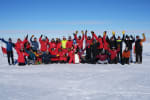When a muon neutrino crashes into the ice, it sometimes produces a hadronic shower and a muon, which are then detected by one of the 5,000 sensors of the IceCube Neutrino Observatory. This hadronic shower carries a fraction of the energy of the original neutrino. This fraction is described by a parameter known as inelasticity. […]
News
Another successful field season for IceCube Upgrade at the South Pole
Since November of last year, a team of IceCube engineers and scientists have been hard at work during the second of three consecutive field seasons for the IceCube Upgrade. Over the course of the season, 37 team members, including 27 drill engineers and 10 installation and operations experts, were deployed to the U.S. National Science […]
Search for neutrino multiplets from transient sources
Ever since high-energy astrophysical neutrinos were first observed in 2013, the IceCube Neutrino Observatory at the South Pole has continued searching for their elusive sources. Thus far, evidence of high-energy neutrino emission has been found from the blazar TXS 0506+056, the active galaxy NGC 1068, and most recently, the Milky Way. Still, neutrino emission from […]
Week 6 at the Pole
And just like that, summer’s over and winter begins. At the Pole last week, a bunch of winterovers stood out on the ice as the last of the summer personnel boarded their plane headed for McMurdo Station, the first leg of their trip home. Below we see front and back views of the IceCube Lab […]
Week 5 at the Pole
A white rainbow? Well, yes—it’s also called a fogbow! Fogbows are rarer than rainbows, and guess what—they’re sometimes referred to as “ghost rainbows.” Sound familiar? More and more summer personnel were leaving the Pole last week, as final touches were put in place to winterize IceCube Upgrade equipment. […]
First IceCube search for heavy neutral leptons
Neutrinos are tiny, nearly massless particles that traverse long distances across the universe, interacting with matter only through the weak force. During their journey through the atmosphere and Earth, they can transform, or “oscillate” from one “flavor”—electron, muon, and tau—to another. This phenomenon has led scientists to conclude that neutrinos have nonzero masses, but despite […]
IceCube search for extremely high-energy neutrinos contributes to understanding of cosmic rays
Neutrinos are chargeless, weakly interacting particles that are able to travel undeflected through the cosmos. The IceCube Neutrino Observatory at the South Pole searches for the sources of these astrophysical neutrinos in order to understand the origin of high-energy particles called cosmic rays and, therefore, how the universe works. IceCube has already shown that neutrinos […]
VERITAS follow-up observations of an IceCube neutrino alert
Cosmic rays are extremely energetic charged particles that zoom through space and bombard the Earth’s atmosphere. Since cosmic rays get diverted by magnetic fields on their way to Earth, tracing their origins is more difficult. However, tiny, nearly massless particles called neutrinos, and photons at similar energies, can be used to trace cosmic rays back […]
Week 4 at the Pole
What’s so funny? Who knows, but a few IceCube folks shared a good laugh out on the ice before leaving the South Pole last week. There were quite a few departures, as the summer season is winding down. There was also a sizeable incoming group—various flight issues had delayed their arrival to the Pole until […]
Week 3 at the Pole
This week’s aerial photo from the South Pole features a 360-degree view from above the IceCube Lab, taken with a camera mounted to a kite. Spectacular! It was a busy week as usual at the Pole, with Upgrade and IceCube maintenance teams working to wrap up summer season tasks. There was ARA work as well, […]









